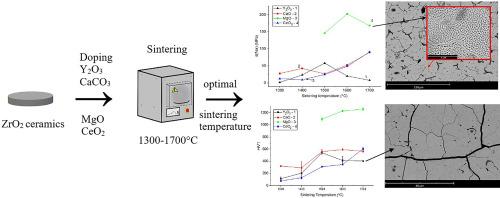Study of the effect of sintering temperature on the microstructure and mechanical properties of stabilized and partially stabilized zirconium dioxide
IF 2.8
Q1 MATERIALS SCIENCE, CERAMICS
引用次数: 0
Abstract
Despite broad utilization of zirconia ceramics in science and industry, significant matters about the structure-property relations in sintered parts are relevant. In this work, to control the microstructure of doped zirconium oxide ceramics with Y, Ca, Mg, Ce dopants sintering at temperatures in the range of 1300 - 1700 °C was carried out. The structure-property relation was studied using XRD, SEM, Vickers and measuring the biaxial flexural strength methods. With an increase in the sintering temperature, significant changes in the microstructure are observed, associated with exaggerated grain growth and the formation of secondary phases. Microhardness vs sintering temperature dependencies show that with increasing temperature, there is an increase in the HV1 values for the ZrO2![]() CaCO3, ZrO2−MgO, ZrO2-CeO2 compositions, which is associated with an increase in the density of ceramics. Optimum sintering temperatures for ZrO2-Y2O3, ZrO2−MgO compositions were found, for which the flexural strengths have the highest values.
CaCO3, ZrO2−MgO, ZrO2-CeO2 compositions, which is associated with an increase in the density of ceramics. Optimum sintering temperatures for ZrO2-Y2O3, ZrO2−MgO compositions were found, for which the flexural strengths have the highest values.

烧结温度对稳定和部分稳定二氧化锆显微组织和力学性能影响的研究
尽管氧化锆陶瓷在科学和工业上有着广泛的应用,但其烧结件的结构-性能关系仍是重要的问题。在1300 ~ 1700℃的烧结温度范围内,对Y、Ca、Mg、Ce掺杂氧化锆陶瓷的微观结构进行了控制。采用x射线衍射(XRD)、扫描电镜(SEM)、维氏硬度(Vickers)和双轴抗折强度测定等方法研究了材料的结构与性能关系。随着烧结温度的升高,微观组织发生了显著变化,晶粒生长加快,二次相形成。显微硬度与烧结温度的关系表明,随着温度的升高,ZrO2CaCO3、ZrO2−MgO、ZrO2- ceo2组分的HV1值增加,这与陶瓷密度的增加有关。找到了ZrO2- y2o3、ZrO2- MgO复合材料的最佳烧结温度,该温度下复合材料的抗弯强度最高。
本文章由计算机程序翻译,如有差异,请以英文原文为准。
求助全文
约1分钟内获得全文
求助全文
来源期刊

Open Ceramics
Materials Science-Materials Chemistry
CiteScore
4.20
自引率
0.00%
发文量
102
审稿时长
67 days
 求助内容:
求助内容: 应助结果提醒方式:
应助结果提醒方式:


